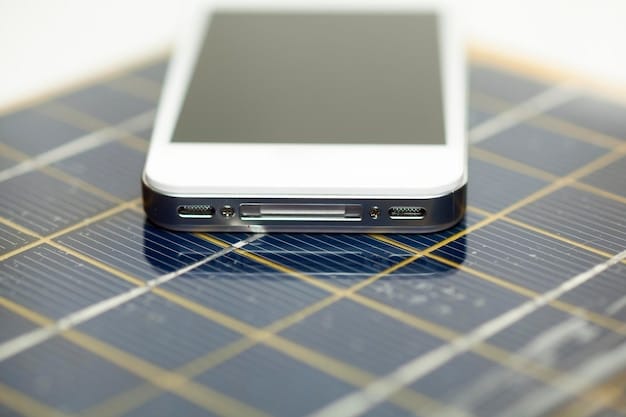Sustainable Tech: Eco-Friendly Gadgets Trending in 2025

Anúncios
The emergence of Sustainable Tech: Eco-Friendly Gadgets Trending in 2025 represents a pivotal shift towards environmentally conscious consumer electronics, driven by advancements in material science, energy efficiency, and circular economy principles, shaping a greener future for technology.
As we approach 2025, the conversation around technology increasingly intertwines with environmental responsibility. The rise of Sustainable Tech: Eco-Friendly Gadgets Trending in 2025 is not just a passing fad but a necessary evolution, reflecting a global conscience eager for innovation that respects our planet. This shift marks a significant move beyond mere performance, embracing a holistic view where a gadget’s ecological footprint is as crucial as its processing power or aesthetics.
The Dawn of Sustainable Electronics
The consumer electronics industry, historically characterized by rapid obsolescence and significant waste generation, is undergoing a profound transformation. This change is spurred by increasing consumer awareness, stricter regulations, and breakthroughs in sustainable design and manufacturing. The focus on eco-friendly gadgets is leading to a new era where technology actively contributes to environmental preservation, rather than solely depleting resources.
The concept of sustainability in tech encompasses various aspects, from reducing energy consumption to employing recycled and recyclable materials, and designing products that are easily repairable and upgradeable. This holistic approach aims to minimize the environmental impact throughout a product’s lifecycle, from extraction of raw materials to its eventual disposal. It’s a departure from the “take, make, dispose” model that has long dominated industrial practices, moving towards a more circular economy.
Driving Forces Behind Eco-Friendly Innovation
Several factors are converging to accelerate the development and adoption of sustainable tech. Consumer demand is a primary driver; an increasing number of individuals are seeking products that align with their environmental values, willing to pay a premium for responsibly made goods. Regulatory pressures, particularly in regions like the European Union, are also pushing manufacturers to comply with stricter environmental standards, including extended producer responsibility and limitations on hazardous substances.
Furthermore, technological advancements themselves are enabling more sustainable practices. Innovations in battery technology, efficient processors, and material science are making it possible to create devices that consume less power and are built from more benign substances. The integration of renewable energy sources, such as solar power, directly into devices is also becoming more common, reducing reliance on grid electricity and dirty power sources.
- Consumer Awareness: A growing segment of the population prioritizes sustainability, influencing purchasing decisions.
- Regulatory Frameworks: Governments are implementing policies that enforce cleaner production and waste management.
- Technological Breakthroughs: New materials and energy solutions are paving the way for truly eco-friendly products.
- Brand Reputation: Companies are increasingly recognizing that sustainability enhances their public image and attracts talent.
The shift towards sustainable electronics is not merely an environmental imperative; it’s also a commercial opportunity. Companies that embrace these principles often find themselves at the forefront of innovation, attracting new markets and building stronger relationships with their customer base. This mutually beneficial relationship between environmental responsibility and economic viability is setting the stage for a future where green tech is the standard, not the exception.
Key Trends in Sustainable Gadgets for 2025
As we look towards 2025, several key trends are defining the landscape of eco-friendly gadgets. These trends reflect a deeper commitment to sustainability across the entire product lifecycle, from design and manufacturing to usage and end-of-life management. We are seeing a move towards devices that are not only greener but also more resilient and adaptable to changing user needs.
One prominent trend is the widespread adoption of recycled and bio-based materials. Manufacturers are increasingly integrating post-consumer plastics, reclaimed metals, and even agricultural waste into their products. This reduces the demand for virgin resources and minimizes the environmental impact associated with extraction and processing. These materials are not just used in packaging but are becoming integral components of the devices themselves, proving that eco-friendly design doesn’t have to compromise on aesthetics or durability.
Modular Design and Repairability
The concept of modularity is gaining significant traction. This design philosophy emphasizes creating devices with easily replaceable components, extending their lifespan and reducing electronic waste. Instead of discarding an entire gadget when a single part breaks or becomes obsolete, users can simply swap out the faulty component or upgrade a specific module. This approach is fundamental to a circular economy, promoting repair over replacement.
Companies are also focusing on improving the repairability of their products. This includes providing accessible repair guides, making spare parts readily available, and designing devices that can be opened and serviced without specialized tools. The “right to repair” movement is playing a crucial role in pushing this agenda, advocating for legislation that empowers consumers to fix their own devices or seek independent repair services.
- Easily Replaceable Parts: Design for user-friendly component swapping.
- Accessible Repair Manuals: Transparent information for DIY and professional repairs.
- Availability of Spare Parts: Ensuring longevity through a robust supply chain for components.
- Tool-Free Access: Simplifying repairs for the average consumer.
Another significant trend is the relentless pursuit of energy efficiency. Gadgets are being designed to consume less power during operation and in standby mode. This is achieved through advancements in processor technology, optimized software, and smart power management systems. The integration of renewable energy capabilities, such as small solar panels on devices, is also contributing to a reduction in their carbon footprint by decreasing reliance on traditional power sources.

Innovations in Materials and Manufacturing
The heart of sustainable tech lies in the materials used and the methods of manufacturing. In 2025, we are witnessing groundbreaking innovations that are fundamentally altering how gadgets are produced, moving towards processes that are less resource-intensive and generate less waste. These advancements are critical for reducing the overall environmental impact of electronics.
One of the most exciting areas is the development of advanced recycled materials. Beyond simply reusing plastics, engineers are creating high-performance polymers from ocean-bound plastic waste, industrial scraps, and even discarded textiles. These materials are then ingeniously incorporated into device casings, internal components, and accessories, maintaining quality and durability while significantly lowering virgin material consumption. Furthermore, the use of recycled aluminum and other metals is becoming standard practice, driven by improvements in recycling infrastructure and processing technologies.
Bio-Based and Biodegradable Solutions
The shift towards bio-based and biodegradable materials is another significant innovation. Researchers are exploring alternatives to traditional plastics derived from fossil fuels, opting for materials made from plant-based sources like cornstarch, wood pulp, or even algae. These bio-plastics offer a reduced carbon footprint during production and, in some cases, can biodegrade at the end of their life cycle, returning to the earth without leaving lasting pollution.
Biodegradable circuits and components are also on the horizon, though still in early stages of development. Imagine a circuit board that, instead of ending up in a landfill, can decompose naturally, leaving no harmful residues. While challenging, this frontier promises truly circular electronics. Moreover, companies are actively experimenting with natural fibers, bamboo, cork, and mushroom mycelium as viable alternatives for device casings and packaging, adding an organic aesthetic to sustainable products.
- Advanced Recycled Polymers: High-performance plastics derived from various waste streams.
- Plant-Based Bio-Plastics: Sustainable alternatives to fossil-fuel based plastics.
- Biodegradable Circuits: Future-gazing efforts for fully decomposable electronic components.
- Natural Fiber Integration: Use of bamboo, cork, and mycelium for casings and packaging.
Manufacturing processes are also becoming greener. The adoption of additive manufacturing (3D printing) can reduce material waste by building products layer by layer, only using what’s necessary. Additionally, factories are increasingly powered by renewable energy sources, and water conservation efforts are being implemented throughout the production line. These combined innovations in materials and manufacturing are crucial steps towards making electronics truly sustainable, reducing their ecological footprint from cradle to grave.
Spotlight on Eco-Friendly Gadgets Trending in 2025
As 2025 unfolds, several categories of eco-friendly gadgets are capturing significant attention, showcasing the diverse applications of sustainable technology. These products exemplify the blend of innovation, practicality, and environmental consciousness that defines the current tech landscape. From personal devices to home appliances, the green revolution is reaching every corner of our digital lives.
Sustainable Smartphones: Manufacturers are making significant strides in producing smartphones with a reduced environmental impact. Besides using recycled aluminum and plastic, 2025 models are featuring modular designs that allow users to easily replace batteries, cameras, and even processors. Companies like Fairphone continue to lead this charge, but mainstream brands are increasingly integrating these principles into their flagship devices, offering extended software support and commitments to long-term repairability. The emphasis is on longevity, reducing the constant cycle of upgrades.
Energy-Efficient Smart Home Devices
Smart home technology is also becoming inherently greener. Devices such as smart thermostats, lighting systems, and energy monitors are not only designed to be energy-efficient themselves but also actively help users reduce their overall energy consumption. New smart plugs can monitor and cut off phantom power drain from appliances, while intelligent lighting systems adjust brightness based on natural light, conserving electricity. Many of these devices are now powered by low-energy wireless protocols and feature components made from recycled materials, closing the loop on their environmental impact.
Solar-Powered Wearables and Chargers: The integration of miniature solar panels into wearable technology like smartwatches and fitness trackers is a growing trend. This allows devices to continuously charge throughout the day, extending battery life and reducing the need for traditional charging cycles. Portable solar chargers for phones and laptops are also becoming more efficient and compact, making off-grid charging a practical reality for eco-conscious consumers. These innovations empower users to lessen their reliance on conventional power grids, especially when on the go.
- Smart Home Systems: Automating energy savings and reducing waste.
- Portable Solar Chargers: Providing off-grid power solutions for mobile devices.
- Recycled Material Electronics: Utilizing post-consumer plastics and metals in device construction.
- Modular Laptops: Enabling component upgrades and easy repairs for extended lifespan.
Recycled Material Laptops and Peripherals: Laptops and accessories are increasingly being constructed from recycled plastics and metals, along with other sustainable materials like bamboo and cork for components or casing. Beyond material choice, these devices often boast higher energy efficiency ratings and are designed for easier disassembly and recycling at end-of-life. The trend is moving towards lightweight, durable products that minimize their environmental footprint throughout their entire operational life.
Challenges and Opportunities in Sustainable Tech
While the momentum for sustainable tech is undeniable, the path forward is not without its challenges. Addressing these hurdles is crucial for the widespread adoption and true impact of eco-friendly gadgets. However, these challenges also present significant opportunities for innovation and market leadership.
One major challenge is the inherent complexity of the global supply chain for electronics. Sourcing ethically and sustainably mined raw materials, ensuring fair labor practices, and managing the intricate logistics of component manufacturing across different continents present formidable obstacles. Transparency and traceability throughout the supply chain are critical but often difficult to achieve, making it hard for consumers to verify the true sustainability credentials of a product.
Bridging the Gap: Performance vs. Green Credentials
Another challenge involves balancing performance expectations with environmental goals. Historically, there’s been a perception that eco-friendly products might compromise on performance or aesthetics. While this gap is rapidly closing, particularly with advancements in materials science, convincing consumers that a sustainable gadget can perform just as well, if not better, than its conventional counterpart remains a marketing and engineering task. The price point also plays a role; sustainable products can sometimes be more expensive due to higher production costs or investment in greener technologies, which can deter budget-conscious consumers.
However, these challenges open doors to immense opportunities. Companies that successfully navigate supply chain complexities through robust auditing and responsible sourcing gain a significant competitive advantage. Brands that genuinely commit to sustainability can build stronger trust and loyalty with consumers, particularly younger generations who prioritize ethical consumption. Furthermore, the development of innovative materials and manufacturing processes not only leads to greener products but can also result in more efficient and cost-effective production in the long run.
- Supply Chain Transparency: A critical yet challenging aspect of true sustainability.
- Performance Parity: Ensuring eco-friendly gadgets match or exceed conventional counterparts.
- Consumer Affordability: Balancing sustainable production costs with market prices.
- Legislation & Standards: Developing universal guidelines for what constitutes ‘sustainable tech’.
The “right to repair” movement, while a challenge for some manufacturers initially, presents an opportunity to build a more engaged and empowered customer base. By making devices easier to repair, companies can extend product lifespans, reduce waste, and potentially create new revenue streams through parts and service. Ultimately, the transition to sustainable tech is not just about making individual products greener, but about reimagining the entire ecosystem of electronics from design to disposal, fostering a more resilient and responsible industry.
The Role of Consumers in Driving Sustainable Tech
Consumers hold immense power in shaping the future of sustainable technology. Their choices, demands, and engagement directly influence how companies innovate and operate. In 2025, an increasingly informed consumer base is expected to be a major catalyst for the widespread adoption of eco-friendly gadgets, solidifying sustainability as a core tenet of product development.
One of the most direct ways consumers exert influence is through their purchasing decisions. By actively seeking out and prioritizing products from brands committed to sustainability, consumers send a clear market signal. This demand encourages more companies to invest in eco-friendly research and development, adopt greener manufacturing processes, and offer products with lower environmental footprints. Every purchase of a recycled smartphone or an energy-efficient appliance reinforces the message that sustainability matters.
Advocacy and Awareness
Beyond purchasing, consumer advocacy plays a vital role. Supporting movements like the “right to repair,” signing petitions, and engaging in discussions about electronic waste and responsible consumption amplify the call for change. Social media and online platforms provide powerful tools for consumers to share information, raise awareness, and hold companies accountable for their environmental claims. Informed consumers are more likely to scrutinize greenwashing – misleading claims about environmental benefits – demanding genuine transparency and verifiable commitments to sustainability.
Education is also key. As consumers learn more about the environmental impact of their electronics, they are better equipped to make informed choices. Understanding concepts like circular economy principles, embodied carbon, and fair labor practices empowers them to evaluate products more critically and demand higher standards from manufacturers. This increased awareness fosters a cycle of continuous improvement within the industry.
- Conscious Purchasing: Prioritizing products with verifiable sustainability credentials.
- Online Advocacy: Utilizing digital platforms to support eco-friendly initiatives.
- Demanding Transparency: Pushing for clear, honest communication from brands about their environmental efforts.
- Engaging in Forums: Participating in discussions that promote sustainable tech practices.
Ultimately, the collective choices of millions of consumers can drive systemic change. As the market for sustainable tech grows, it becomes more economically viable for companies to invest further in green innovations. Consumers are not just end-users; they are active participants in a global movement towards a more sustainable and responsible technological future. Their growing demand for products that are good for both people and the planet is the force truly powering Sustainable Tech: Eco-Friendly Gadgets Trending in 2025.
Future Outlook: Beyond 2025 for Sustainable Tech
Looking beyond 2025, the trajectory for sustainable technology points towards deeper integration, more radical innovations, and an even stronger emphasis on circular economy principles. The foundational changes being made now will pave the way for a tech ecosystem that is inherently regenerative, rather than merely less harmful. This long-term vision encompasses not just individual gadgets but the entire lifecycle and infrastructure supporting them.
One primary area of development will be in self-healing materials and components. Imagine a phone screen that can repair its own minor scratches, or circuit boards that are resistant to degradation. This field is still in its infancy but promises to exponentially extend the lifespan of devices, significantly reducing the need for replacements and repairs. Furthermore, advancements in advanced recycling techniques will allow for the recovery of a greater percentage of valuable materials, including rare earth elements, making the urban mine a truly viable resource.
Personalized Sustainability and AI Integration
The future of sustainable tech will also see more personalized approaches to consumption. Artificial intelligence (AI) could play a larger role in helping consumers manage their device lifecycles more effectively, providing personalized recommendations for repairs, upgrades, and responsible recycling. AI-powered platforms could also analyze consumption patterns to suggest more sustainable alternatives, effectively making eco-conscious choices effortless for the user. This data-driven approach will empower consumers to take concrete steps towards reducing their digital footprint.
Moreover, the concept of “product-as-a-service” could become more prevalent. Instead of owning a device outright, consumers might lease products that are maintained, repaired, and upgraded by the manufacturer. This model shifts the responsibility of longevity and end-of-life management to the producer, who has a vested interest in designing durable, repairable, and recyclable products. This economic model incentivizes true circularity and resource efficiency, transforming our relationship with technology.
- Self-Healing Materials: Enhancing device durability and lifespan.
- Advanced Resource Recovery: Improving the efficiency of material recycling.
- AI-Driven Eco-Management: Personalized insights for sustainable tech use.
- Product-as-a-Service Models: Shifting ownership to prioritize longevity and repair.
Ultimately, the long-term vision for sustainable tech involves more than just individual green gadgets; it’s about fostering an entire ecosystem that is designed with ecological integrity at its core. This includes not only cleaner hardware but also energy-efficient data centers, green software development practices, and robust recycling infrastructures. The journey beyond 2025 signifies a mature and deeply integrated approach to technology that serves both human needs and the health of the planet, moving towards a truly symbiotic relationship with our digital tools.
| Key Point | Brief Description |
|---|---|
| ♻️ Material Innovation | Focus on recycled, bio-based, and biodegradable materials to reduce environmental footprint. |
| 🔧 Modular & Repairable Design | Gadgets designed for easy disassembly, component replacement, and extended lifespan. |
| ⚡ Energy Efficiency | Devices optimized to consume less power, often integrating renewable energy sources like solar. |
| 👩💻 Consumer Influence | Purchasing decisions and advocacy play a crucial role in driving the sustainable tech market. |
Frequently Asked Questions About Sustainable Tech
A sustainable gadget is designed, manufactured, used, and disposed of in a way that minimizes environmental harm. This includes using recycled or bio-based materials, being energy-efficient, offering modular or repairable design for longevity, and having responsible end-of-life processing. Its entire lifecycle is considered to reduce its ecological footprint from production to disposal.
Modularity enhances longevity by allowing users to easily replace specific components, like batteries or cameras, rather than discarding the entire device. This dramatically reduces electronic waste and the need for new product manufacturing, supporting circular economy principles where products are used for longer and materials are recycled more effectively.
Look for certifications from reputable third-party organizations (e.g., EPEAT, Energy Star), transparency in supply chains, and clear commitments to repairability and recycling. Research brands that prioritize recycled content, offer extended warranties, and provide accessible spare parts. Beware of vague “green” claims without specific, verifiable details to avoid greenwashing.
Renewable energy sources, such as integrated solar panels in wearables or portable solar chargers, reduce reliance on grid electricity. This lowers the carbon footprint associated with device charging, especially when traditional power sources are fossil-fuel based. They also provide greater energy independence for users, contributing to a more distributed and sustainable energy ecosystem.
The “right to repair” movement advocates for legislation that gives consumers and independent repair shops the ability to fix electronics. This promotes product longevity, reduces e-waste, and encourages manufacturers to design more durable and repairable devices. It shifts the industry towards a model where products are valued for their lifespan rather than planned obsolescence.
Conclusion
As we navigate the technological landscape of 2025 and beyond, it’s clear that sustainability is no longer a niche, but a fundamental pillar of innovation. The advancements in Sustainable Tech: Eco-Friendly Gadgets Trending in 2025 demonstrate a crucial shift towards products that serve our needs without compromising the planet’s health. From intelligent material choices and modular designs to consumer advocacy and energy efficiency, the collective effort across the industry and among users is shaping a future where technology and environmental responsibility are inextricably linked. The promise of fully circular electronics, self-healing materials, and AI-driven sustainability solutions paints an optimistic picture, proving that a greener, more responsible tech ecosystem is not just a dream, but an achievable reality.





